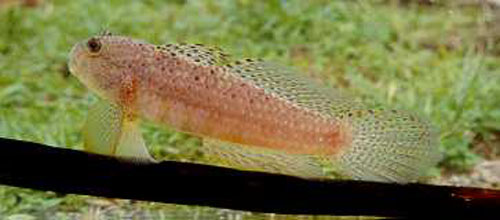| Gobiidae (Gobies), subfamily: Gobiinae |
| 16.2 cm TL (male/unsexed) |
|
reef-associated; brackish; marine; depth range 0 - 5 m |
| Western Pacific: Andaman Islands to Vanuatu, north to Japan, south to New Caledonia. Occurs in the Mekong delta, but possibly may be found as far upstream as the tidal zone (Ref. 12693). |
|
Dorsal spines (total): 7-7; Dorsal soft rays (total): 10-11; Anal spines: 1-1; Anal soft rays: 9-10; Vertebrae: 26-26. Ground color brown, darker dorsally; dusky spots proximally on pectoral fin; blackish pelvic fins. 10 or more predorsal scales. Cheeks and opercula fully scaled. Spines of 1st dorsal fin elongated into filaments. Differs from E. belissimus by having fewer predorsal scales and slightly different details of coloration (Ref. 1602); characterized further by having pectoral rays 16-18; rounded caudal fin; longitudinal scale series 30-33; ctenoid scales except cycloid on nape and isthmus; depth of body 3.6-4.0 in SL (Ref. 90102). |
| Solitary or in groups (Ref. 90102). Inhabits muddy bottoms of shallow, turbid marine to brackish coastal inlets and estuaries. Also lives in shallow coastal waters, large tidal pools, mangroves, siltty lagoons and brackish lakes (Ref. 48637). |
|
Least Concern (LC); Date assessed: 26 April 2020 Ref. (130435)
|
| harmless |
Source and more info: www.fishbase.org. For personal, classroom, and other internal use only. Not for publication.

